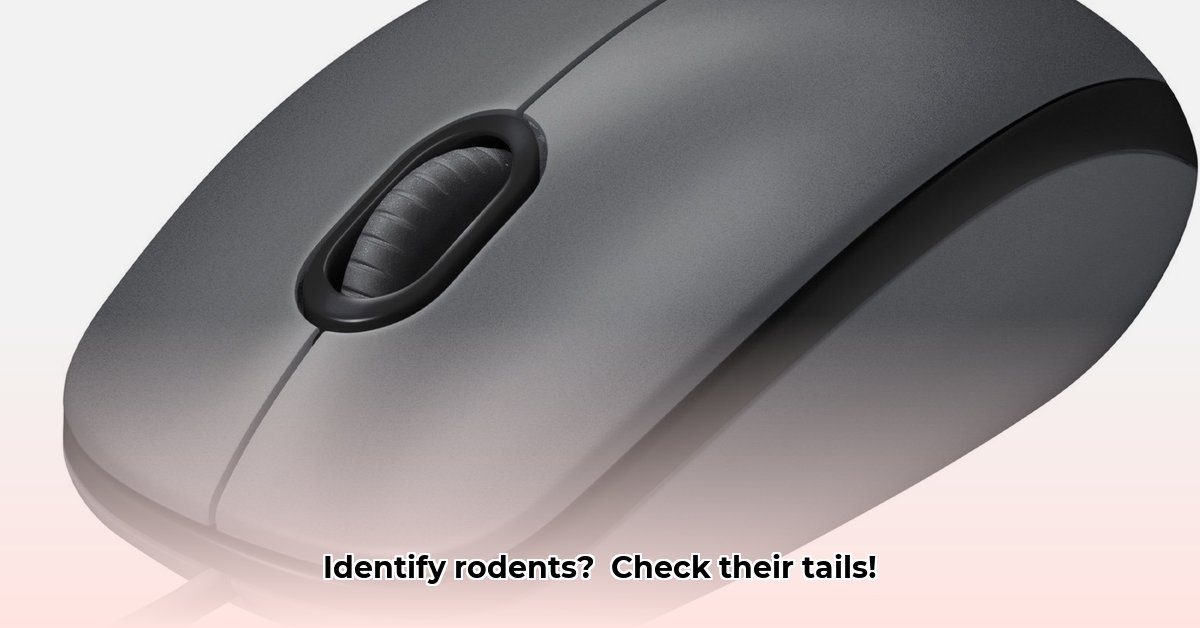Knowing how to tell mice and rats apart is key for pest control, animal care, and public health. Their tails offer significant clues! Though similar, mouse and rat tails have distinct characteristics. This guide helps you confidently identify rodents by examining tail length, furriness, and color. With this knowledge, you can handle any rodent situation effectively. Understanding the physical characteristics of mouse tails can aid in quick rodent ID and effective pest management.
Mouse Tail: Your Key to Speedy Rodent ID
Leveraging tail characteristics for rodent detection and identification.
Mouse tails hold vital information for identifying rodents, from pest control experts to nature enthusiasts. Understanding mouse tail characteristics can be surprisingly helpful in determining the type of rodent you are dealing with. Recognizing key features in the tail will help you quickly identify the type of mouse.
Decoding the Mouse Tail: More Than Just a Wiggle
Mouse tails provide clues for identifying different species. Factors such as length, furriness, and appearance are all helpful. A closer examination of a mouse tail reveals surprising details that can help determine the identity of the rodent. Paying attention to the tail can help you identify the rodent type.
Mice vs. Rats: A Tail Tale of Two Rodents
Mice and rats use their tails for balance and warmth, but the tails have major differences. Rat tails are generally shorter, thicker, and proportionately smaller relative to their body size. Rat tails are mostly bare and scaly, while mouse tails are usually covered in fur. This difference affects how they regulate body temperature; rat tails dissipate heat, while mouse tails provide insulation. This contrast is crucial for rodent identification.
Mouse Tail Mysteries: A Closer Look
Examine a mouse tail carefully, noting its thickness, length relative to the body, color, and fur coverage. These details can help narrow down the species. Paying attention to these specific details helps in accurate categorization of the mouse.
Beyond the Basics: Tail Shape and Lifestyle
Understanding the environmental factors that affects tail shape.
Tail shape reveals habits and habitats. A long, flexible tail suggests a mouse that climbs, while a shorter, stiffer tail indicates a burrowing mouse. These clues provide insights into the mouse’s daily life and environment. The tail shape indicates the habitat the mouse comes from.
Identifying Mice: A Step-by-Step Guide
Use these steps to identify mice by their tails:
- Measure the Tail Length: Measure the tail from base to tip using a ruler or measuring tape. Record the length in centimeters or inches.
- Check the Tail’s Thickness: Note the thickness at the middle. A digital caliper can provide a precise measurement in millimeters.
- Examine the Fur: Determine if it’s fully, partially, or completely bare. Note the color and density of the fur, if present.
- Note the Tail Color: Record the color and any patterns. Check if the color is uniform or bicolored.
- Feel the Texture: Determine if the tail is smooth, rough, or scaly by gently running your fingers along the surface.
- Compare Your Findings: Consult a field guide or expert to confirm your findings. Online databases and local pest control services can also assist with identification.
Mouse Tails Versus Rat Tails: A Side-by-Side Comparison
| Feature | Mouse Tail | Rat Tail |
|---|---|---|
| Relative Length | Roughly equal to body length | Shorter than body length |
| Fur Coverage | Usually furred | Hairless, scaly |
| Thickness | Thinner | Thicker |
| Texture | Typically soft, sometimes silky | Rough, scaly |
| Color | Often uniform (browns and grays common) | Variable, often two-toned (darker above, lighter below) |
Identifying a rodent correctly involves examining features beyond its tail, such as body size, ear shape, and behavior. The mouse tail, with its subtle differences, serves as an excellent starting point. By observing and comparing tail characteristics, you can begin to identify the rodent.
How to Differentiate Mouse and Rat Tails Using Quantitative Data
Key Takeaways:
- Mouse tails are roughly the same length as their bodies; rat tails are shorter.
- Mouse tails are thinner and hairier; rat tails are thicker and scaly.
- Rat tails play a more significant role in thermoregulation.
- How to differentiate mouse and rat tails using quantitative data requires measuring tail length, thickness, and comparing these to body length. Precise measurements are needed for accurate identification.
- Significant discrepancies exist in current data on mouse tail thermoregulation, highlighting the need for further research.
Tail Length: A First Glance
Tail length as an initial identifier in rodent identification.
Length is the most obvious difference. Mouse tails usually match their body length, whereas rat tails are significantly shorter relative to their body size. This offers a quick way to start the identification process. How to differentiate mouse and rat tails using quantitative data requires accurate measurements.
Measuring for Accuracy
Measure the tail (base to tip) and body length (nose to tail base) of both the mouse and rat using a ruler or calipers. Calculate the tail-to-body length ratio for each, revealing a lower ratio in rats. For example, a mouse with a 10cm body might have a 9-11cm tail, while a rat with a 20cm body might have a 10-15cm tail. This quantitative approach provides more reliable identification than visual estimations.
Texture and Hair: Feeling the Difference
Beyond length, texture and hair are telling. Mouse tails are typically covered in soft, fine hair, while rat tails are mostly hairless and scaly. Rat tails feel noticeably thicker. Use a micrometer to measure the diameter at the tail base, providing a numerical comparison (e.g., mouse: 2-3mm, rat: 4-6mm), further enhancing analysis.
Coloration: Beyond Black and White
Understanding the significance of tail pigmentation in rodent identification.
Color can be a helpful but less reliable clue. Mouse tails usually match their body color. Rats often have lighter-colored tails than their bodies, although this can change. The color of the tail may change or darken based on cleanliness and environmental factors. Variations can range from pinkish-gray to dark brown.
Thermoregulation: The Heat Factor
Rat’s hairless tails are important for thermoregulation, allowing them to dissipate heat efficiently. While a mouse’s tail contributes some heat dissipation, it’s less significant than in rats due to its fur covering. This reflects their environments and behaviors. Further quantitative data is needed to understand the exact contribution of a mouse’s tail to thermoregulation under varying environmental conditions.
Putting It All Together: A Table for Comparison
| Feature | Mouse | Rat |
|---|---|---|
| Tail Length | ≈ Body Length (Ratio ≈ 0.8-1.2) | < Body Length (Ratio ≈ 0.5-0.75) |
| Tail Thickness | Thin (2-3mm diameter) | Thick (4-6mm diameter) |
| Tail Hair | Furry, fine | Hairless, scaly |
| Tail Color | Usually matches body color | Often lighter than body color |
| Thermoregulation | Minor contribution | Significant contribution |
| Quantitative Data Needed | Tail length (cm), body length (cm), tail thickness (mm) | Tail length (cm), body length (cm), tail thickness (mm) |
| Understanding quantitative data helps to identify the rodent. |
Rodent Tail Morphology for Effective Pest Management Strategies
Key Takeaways:
- Rodent tail length strongly correlates with temperature (Allen’s Rule).
- Tail color and texture vary with habitat.
- Prehensile tails are common in tree-dwelling rodents.
- Tail morphology aids in rodent identification. This is crucial for Rodent Tail Morphology for Effective Pest Management Strategies.
- Understanding tail characteristics improves pest control effectiveness.
Deciphering the Clues: Tail Length and Temperature
Tail length reflects the environment. Rodents in colder climates tend to have shorter tails for heat conservation (Allen’s Rule). A shorter tail means less surface area from which to lose heat. This is a key component of Rodent Tail Morphology for Effective Pest Management Strategies. Expect longer tails in warmer climates, where increased surface area aids in heat dissipation.
Habitat and Hues: Tail Color and Texture
Tail color and texture tell a story. Darker tails provide camouflage in shady environments. Lighter tails could be advantageous in sun-drenched areas by reflecting sunlight and reducing heat absorption. Bushy tails offer insulation in cold climates, whereas sparsely furred tails suit hot, dry regions, facilitating heat loss. These variations inform Rodent Tail Morphology for Effective Pest Management Strategies.
Treetop Tenants vs. Open-Field Dwellers: Tail Function and Behavior
Understanding the habitats of rodent types.
The tail’s role extends beyond thermoregulation. Prehensile tails, common in arboreal rodents, act like a fifth limb for climbing, providing grip and stability in trees. Rodents in open fields might have tails for balance and rapid movements, lacking prehensile capabilities but specialized for quick directional changes and stability during
- Understand the Dunning-Kruger Effect: Why Incompetent People Think They’re Experts: Gain Self-Awareness - August 1, 2025
- Ignaz Semmelweis: The Doctor Fired for Handwashing: A Public Health Tragedy - August 1, 2025
- Unlock Your Memory: Spaced Repetition: The Scientific Trick to Remembering Information Forever: Learn Effortlessly - August 1, 2025
















